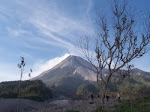By: Netherlands Organization for Scientific Research
The large forest fires that sweep through Indonesia in dry periods are not only the result of severe drought. A team of researchers, including Veni grant winner Guido van der Werf, has analysed the density of smog during forest fires. They have now established that the intensity of the forest fires is directly linked to population density and land use. Nature Geoscience published the results of the research on 22 February.
The biggest problem of the fires in Indonesia is not the fire itself but the poisonous smoke released. Due to this smoke, the number of people killed by fires in Indonesia is probably many times higher than that in Australia this year. Furthermore, the smog also causes severe damage to the environment. Knowledge about the causes of these fires is essential for improved predictions of major fire years.
Where there's smoke...
The researchers used the thick smoke produced by the Indonesian fires to analyse the forest fires. Due to a lack of good satellite images, little is known about fires that took place before the 1990s. The researchers solved this problem by using other data recorded daily during the past fifty years, namely the visibility observations and meteorological data from airports.
One of the most interesting results from the study was that low rainfall in Sumatra has been resulting in fires since at least 1960, while in Kalimantan this has only been the case since 1980. Kalimantan was fairly resistant to dry periods up until 1980, but since then Kalimantan has become far more prone to fires prone during drought years. The population of Sumatra grew rapidly in the 1960s. However, a comparable increase in the population was not seen in Kalimantan until the 1980s.
The rising population on Kalimantan was accompanied by a change in land use from small-scale subsistence agriculture to large-scale industrial agriculture and agroforestry. In order to support this change, large areas of peatlands were drained and deforestation took place on a grand scale. These changes in land use and population density made Kalimantan far more fire prone. Although the enormous influence of this man-made change was already suspected, this is the first time that these claims have been substantiated by reliable data.
Climate change
In addition to the major human influences, the researchers also analysed the influence of two meteorological phenomena. The influence of El Nino on the amount of rainfall was already known, but the Indian Ocean Dipole, that exerts a major influence on the water surface temperature, appeared to be an equally important factor.
Although severe drought provides the conditions conducive for forest fires, it is often humans who are actually responsible. Many of the fires are deliberately started to free up land for agriculture. The sustained burning of biomass not only releases the greenhouse gases carbon dioxide and methane but also large quantities of carbon monoxide and particulate matter. Consequently, during major fire years the air quality in Indonesia is many times worse than that of the most polluted cities of the world. Moreover, the polluted air also affects people living in neighbouring areas.
Researcher Guido van der Werf from the VU University Amsterdam carried out his research in collaboration with Robert Field and Samuel Shen. In 2008, Van der Werf was awarded NWO's prestigious Vening Meinesz prize for the most promising young researcher in the earth sciences.
Source: YubaNet.com
Friday, May 29, 2009
Subscribe to:
Post Comments (Atom)





0 comments:
Post a Comment